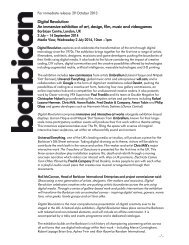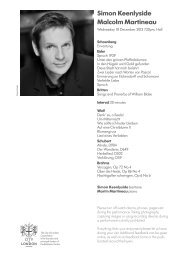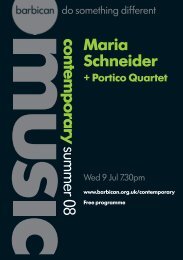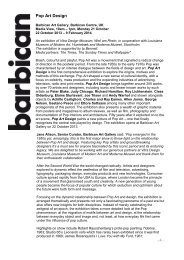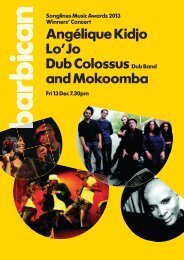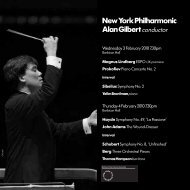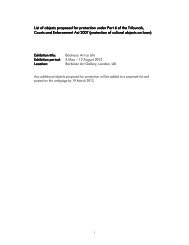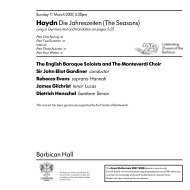Create successful ePaper yourself
Turn your PDF publications into a flip-book with our unique Google optimized e-Paper software.
Benjamin <strong>Britten</strong> at 100<br />
Benjamin <strong>Britten</strong> was born on <strong>22</strong> <strong>Nov</strong>ember<br />
– feast day of St Cecilia, patron saint of music<br />
– making it hard not to see his career as fated,<br />
somehow meant to be. It’s a sensation that<br />
only grows when you think of the precocious<br />
young <strong>Britten</strong> producing his first ‘compositions’<br />
at just 5 years old in a house that didn’t<br />
even contain a gramophone, displaying an<br />
instinctive talent only partially explained by the<br />
enthusiasm of his amateur-musician mother.<br />
Tonight’s concert marks <strong>Britten</strong>’s 100th birthday<br />
with a programme of the composer’s works<br />
for choir. Although he is arguably best-known<br />
for his operas, it is in the choral writing that we<br />
find the real musical constant, the touchstone,<br />
of his career. Spanning 45 years, tonight’s<br />
programme is bookended by the Hymn to the<br />
Virgin (written when <strong>Britten</strong> was just 16) and<br />
Sacred and Profane (dating from the year<br />
before his death), tracing the development<br />
of a composer from his earliest explorations<br />
to musical maturity and sophistication.<br />
Confined to his boarding-school sanatorium by<br />
illness, the teenage <strong>Britten</strong> wrote the carol that<br />
would become one of his best-loved pieces –<br />
the exquisite Hymn to the Virgin. It carries great<br />
significance on slight musical shoulders – having<br />
gained the composer entry to the Royal College<br />
of Music – and would eventually be one of only<br />
two pieces performed at his own funeral. It was<br />
also the first of four such hymns that <strong>Britten</strong> would<br />
produce, each dedicated to a different saint.<br />
<strong>The</strong> Hymn to the Virgin is a perfect miniature,<br />
setting an anonymous medieval text with a<br />
delicacy occasionally overshadowed in <strong>Britten</strong>’s<br />
later works by complexity. <strong>The</strong> composer<br />
divides his eight voices into two SATB choirs.<br />
While one remains grounded in the earthly<br />
by its English text, and in the human by its<br />
emotional crescendos and climaxes, the other<br />
is set at a distance. Singing only in Latin, these<br />
other-worldly voices echo and transmute the<br />
utterances of the first choir into music that’s<br />
unchanging, eternal. In <strong>Britten</strong>’s hands a<br />
simple, strophic hymn is itself transfigured.<br />
If the skill of the Hymn to the Virgin lies in its<br />
restraint, then the Hymn to St Cecilia is entirely<br />
the opposite. Emerging from the same flurry<br />
of creativity as A Ceremony of Carols (and<br />
at least partially composed on the same sea<br />
voyage home from America in 1942), the<br />
work is the product of a new optimism, a reembracing<br />
of national identity and professional<br />
purpose that characterised <strong>Britten</strong>’s return<br />
from self-imposed exile. Publicly attacked for<br />
the pacifist convictions that drove him from<br />
England during the war, <strong>Britten</strong> now faced<br />
up to his critics, setting English texts again<br />
in that most English of genres, the choral<br />
anthem, for the first time since his departure.<br />
And which poet could he choose but<br />
W H Auden? Auden’s verse had already<br />
proved a match and spur to <strong>Britten</strong>’s musical<br />
skill, and would here drive him even further. An<br />
ode in praise of the patron saint of music, the<br />
poem is divided into three sections which form<br />
three short movements for unaccompanied<br />
SSATB choir. <strong>The</strong> first takes its cue from Purcell,<br />
constructing the flowing, modal lines of the<br />
sopranos and altos over a sort of ground bass<br />
in the lower voices. <strong>The</strong> refrain, a variation of<br />
which divides each movement, derives from<br />
the music of this opening. <strong>The</strong> central section,<br />
‘I cannot grow’, is a breathless scherzo, the<br />
scalic innocence and simplicity of its melody<br />
4




